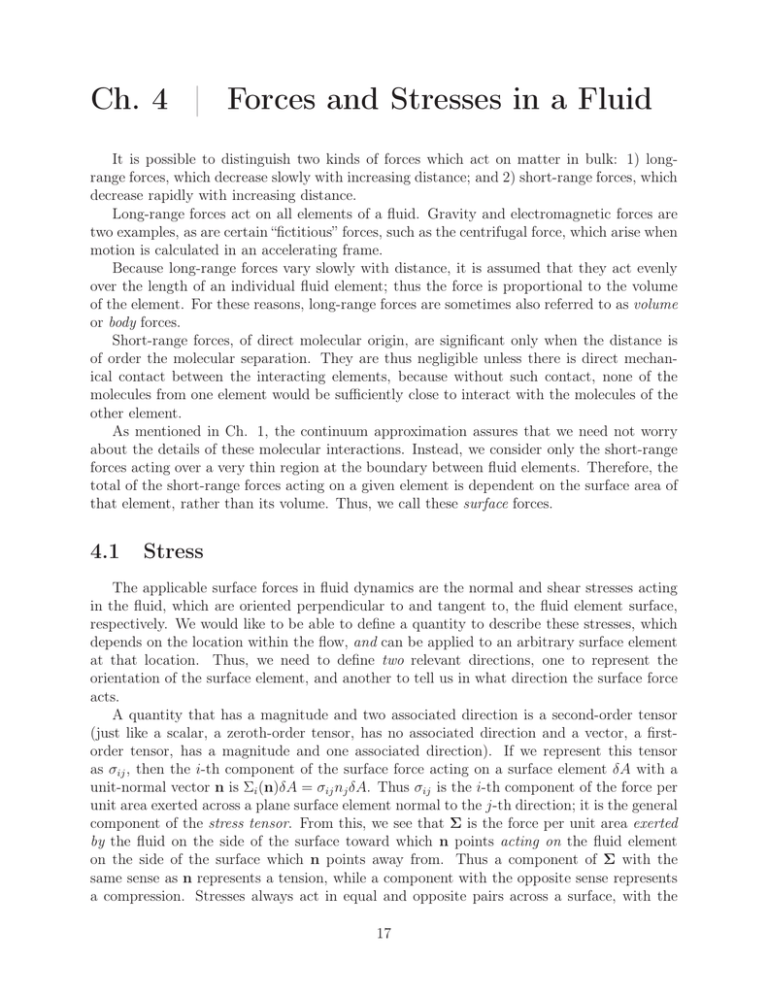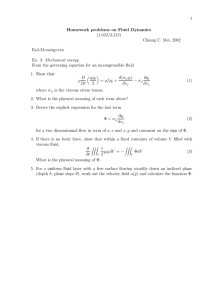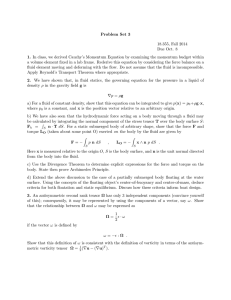Ch. 4 | Forces and Stresses in a Fluid
advertisement

Ch. 4 | Forces and Stresses in a Fluid It is possible to distinguish two kinds of forces which act on matter in bulk: 1) longrange forces, which decrease slowly with increasing distance; and 2) short-range forces, which decrease rapidly with increasing distance. Long-range forces act on all elements of a fluid. Gravity and electromagnetic forces are two examples, as are certain “fictitious” forces, such as the centrifugal force, which arise when motion is calculated in an accelerating frame. Because long-range forces vary slowly with distance, it is assumed that they act evenly over the length of an individual fluid element; thus the force is proportional to the volume of the element. For these reasons, long-range forces are sometimes also referred to as volume or body forces. Short-range forces, of direct molecular origin, are significant only when the distance is of order the molecular separation. They are thus negligible unless there is direct mechanical contact between the interacting elements, because without such contact, none of the molecules from one element would be sufficiently close to interact with the molecules of the other element. As mentioned in Ch. 1, the continuum approximation assures that we need not worry about the details of these molecular interactions. Instead, we consider only the short-range forces acting over a very thin region at the boundary between fluid elements. Therefore, the total of the short-range forces acting on a given element is dependent on the surface area of that element, rather than its volume. Thus, we call these surface forces. 4.1 Stress The applicable surface forces in fluid dynamics are the normal and shear stresses acting in the fluid, which are oriented perpendicular to and tangent to, the fluid element surface, respectively. We would like to be able to define a quantity to describe these stresses, which depends on the location within the flow, and can be applied to an arbitrary surface element at that location. Thus, we need to define two relevant directions, one to represent the orientation of the surface element, and another to tell us in what direction the surface force acts. A quantity that has a magnitude and two associated direction is a second-order tensor (just like a scalar, a zeroth-order tensor, has no associated direction and a vector, a firstorder tensor, has a magnitude and one associated direction). If we represent this tensor as σij , then the i-th component of the surface force acting on a surface element δA with a unit-normal vector n is Σi (n)δA = σij nj δA. Thus σij is the i-th component of the force per unit area exerted across a plane surface element normal to the j-th direction; it is the general component of the stress tensor. From this, we see that Σ is the force per unit area exerted by the fluid on the side of the surface toward which n points acting on the fluid element on the side of the surface which n points away from. Thus a component of Σ with the same sense as n represents a tension, while a component with the opposite sense represents a compression. Stresses always act in equal and opposite pairs across a surface, with the 17 18 CH. 4. FORCES AND STRESSES IN A FLUID sign convention chosen such that σij is positive when the stress on the lower xj side is in the positive xi direction. The net force per unit volume on a fluid particle, which is what we will eventually need, is given by the differences in the stresses acting across opposite faces. In the xi -direction this is ∂σij /∂xj . It can be shown that σij must be symmetrical, that is σij = σji , and thus has only six independent components. The diagonal components of σij are normal stresses in the sense that each one gives the normal component of the surface force acting across a plane surface element parallel to one of the coordinate planes. The six non-diagonal components are tangential stresses, sometimes called shearing stresses, because they are set up by shearing motion in which parallel layers of fluid move relative to each other. It is always possible to choose the directions of the orthogonal axes of reference so that the non-diagonal elements of a symmetrical second-order tensor are all zero. Such axes are referred to as the principal axes of the stress tensor. The diagonal elements of the stress ! ! ! tensor become the principle stresses σ11 , σ22 , σ33 . The sum of the diagonal elements of the tensor remain unchanged under such a transformation so that σii! = σii , that is, the sum of the principle stresses equals the sum of the diagonal elements of the stress tensor for any set of orthogonal basis vectors. 4.2 Pressure As we will see in the next chapter, a fluid at rest, by construction, does not exhibit relative motion between parallel layers. Thus, there can be no shear forces (forces parallel to a surface element). In other words, the only stresses that can act in a fluid at rest are ones normal to the surface area elements of the fluid. This must be true for any orientation of orthogonal axes within the fluid; therefore, all axes are principle axes and the principle ! ! ! stresses σ11 , σ22 , σ33 must all be the same and equal to (1/3)σii . Thus the stress tensor in a fluid at rest (or hydrostatic fluid) is everywhere isotropic (appears the same in all directions). We define the hydrostatic pressure as P = −(1/3)σii . For a fluid at rest, then, the stress tensor is σij = −P δij , where δij is the Kronecker delta function. The force per unit area exerted across a plane surface with unit normal n is −P n; this has the same magnitude for any direction at a given point. The minus sign comes from the sense that this is the force per unit area exerted by the fluid outside the surface on the fluid element inside the surface. 4.3 Viscosity More often, the total stress acting in a fluid has contributions from both pressure and viscosity, σij = −P δij + τij . (4.1) In this case, the net force per unit volume on a fluid particle in the xi -direction is ∂σij ∂P ∂τij =− + , ∂xj ∂xi ∂xj (4.2) 19 4.3. VISCOSITY where ∂τij /∂xj is the viscous force per unit volume. Viscous stress opposes relative motion between neighboring fluid particles. Equivalently it opposes the deformation of fluid particles. For a Newtonian fluid τij is linearly related to the rate of strain tensor eij : τij = Λijkl ekl where Λijkl is an isotropic (4th-order) tensor. Further, the rate of strain tensor is just the symmetric part of the velocity gradient tensor ξij = ∂ui /∂xj : 1 eij = (ξij + ξji ) . 2 The most general form of Λijkl is Λijkl = λδij δkl + ξδik δjl + χδil δjk , where λ, ξ, and χ are, as yet, unspecified parameters. This gives τij = λδij ekk + (ξ + χ)eij (4.3) where we have utilized the fact that eij = eji . This relation can be modified further by noting that ekk = ∂uk /∂xk = ∇ · u and ξ + χ = 2µ, where µ is called the coefficient of viscosity. Finally, " ! ∂ui ∂uj + + λδij ∇ · u . (4.4) τij = µ ∂xj ∂xi For an incompressible fluid, the term involving λ in (4.4) drops out (because of the continuity equation for an incompressible fluid). If µ is also taken to be a constant, then the expression for the viscous force per unit volume reduces to µ∇2 u (4.5) Because this form is much simpler than the full expansion of ∂τij /∂xj , it is common to make these assumptions even when the density and/or viscosity do vary appreciably. It is worth noting that the viscous force per unit volume, ∂τij /∂xj , is zero for a fluid at rest or moving with a uniform velocity, as expected, since the action of viscosity is to oppose relative motion within the fluid. 20 CH. 4. FORCES AND STRESSES IN A FLUID




